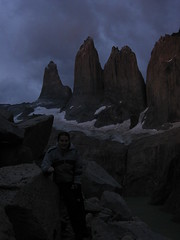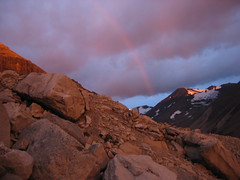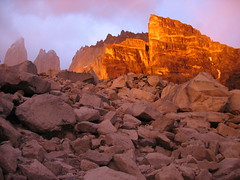Day 2: The Torres of Torres del Paine
16 February 2007
12:00 AM
Torres del Paine — Day 2
February 1, 2007
As planned, my alarm went off at 3:55am. It was not a pleasant sound. Not according to plan, however, was the torrential downpour pounding our tent, as it had been doing since midnight. The forecast for the day was a smiling sun. There might be sun at some other point during the day, but for now it sounded like bullets were raining down on us. I’d hate to see a day when rain is forecast.
The rain provided a pretty powerful incentive to stay in bed, as did the time of day. Fortunately Amanda and I had setup a more powerful still peer pressure system: we had hiked until 10:20 the night before to set up this one-shot opportunity to see sunrise at the Torres, and neither one of us wanted to be the one to suggest staying in bed. We were moving slowly, but moving, which was itself a victory. We split a chocolate Pop-Tart, put on our rainpants and raincoats, and with our headlamps on we left the protection of our dry tent for the dark, wet, cold morning.
It was a deluge in pure blackness. When I turned off my light I couldn’t even see the tent I had just exited. There were about 30 other tents at our campsite, but my headlamp was the only illumination around. The beam of light caught the raindrops for a moment as they passed my face. It made it look like I was in the middle of an electrical storm, with a shower of sparks pouring over me. I wanted to take a picture, but with so much water I knew it would have been my camera’s last.
We started up the trail at 4:20am. From camp the Torres are supposedly 45 minutes west. The sun was supposed to rise at 5:09am. Neither turned out to be the case for us, although the problems cancelled each other out: our trek was longer, but the sun rose later. The incorrect sunrise time was a typo—one of the only two I could see—in the park guide. See if you can find both mistakes in this sunrise chart:
| Date | Sunrise |
|---|---|
| Dec 10 | 5:14am |
| Dec 20 | 5:15am |
| Dec 30 | 5:21am |
| Jan 10 | 5:35am |
| Jan 20 | 5:52am |
| Jan 30 | 5:09am |
| Feb 10 | 6:30am |
| Feb 20 | 6:48am |
| Feb 30 | 7:04am |
Since Dec 21 is the summer solstice and the longest day of the year (at least in this hemisphere), sunrise should be earliest on that day and get later each subsequent day. There’s a break from that pattern on January 30, where sunrise is listed at 5:09am. Ten days earlier it was at 5:52am; ten days later at 6:30am. Sunrise probably should have been listed at 6:09am. We fell victim to a cruel mistake that got us out of bed far earlier than necessary.
That turned out to be a blessing because 45 minutes to climb the hill is an aggressive estimate, most likely based on the speed of a hungry puma. The trail to the Torres—which means “towers”—is only a mile long, but in that distance you scramble up rocky boulder fields to rise 1300 vertical feet (i.e. the Empire State Building). Thankfully we had left our backpacks in our tent, so we weren’t carrying our sacks o’ lead. (Theft isn’t a problem on the trail, either because of some backpacker code of honor, or perhaps because only an idiot would deliberately increase his pack’s weight.) The trail—I am being charitable in my description—was marked periodically with orange dots painted on rocks and trees. Whoever marked the trail was either drunk or very forgetful. Sometimes we would go what seemed like ten minutes without seeing anything, then we would see four dots on two rocks ten feet apart. Our situation was further complicated by the darkness and the rain. Amanda and I probed the night with the surgical beams of our headlamps, scanning for colored circles on rocks.
“I don’t see anything. Do you see anything?”
“Uh-uh. Are you sure this is the trail?”
“No. Wait! Is that a dot over there?”
“Where? I don’t see it.”
“Over there by that rock.”
“That one? Which one?”
“Right there, where my light’s pointing.”
Sometimes it would be another precious dot left by the Mad Dotter. Just as often we would get excited only to find that it was a patch of orange lichens or a discoloration on the rock.
Finally, after about an hour and twenty minutes of climbing, after dot after dot after dot, we caught a glimpse of the Torres. They were an imposing black silhouette against a slightly less black sky. Ribbons of ice twisted along the base. Melting snow cascaded downward in a handful of tall, thin waterfalls until it collected in a glassy smooth lake beneath the towers. To the right of the Torres was the massive Condor’s Nest peak. With the big picture to orient us, we reached the viewpoint as the sun was painting the clouds at our backs a faint pink.
| Timelapse of sunrise at the Torres | |||
 5:55am |
 6:06am |
 6:19am |
 6:23am |
We sat and waited for the sun to rise. In the meantime, we were completely alone with the iconic formation—the namesake—of the park. As the rays began to peek through the valley, the Torres lit up. On cue, the rain stopped. We sat admiring in the ferocious wind. We took pictures with my camera, which I almost lost to a particularly strong gust of wind. We took pictures with our minds to capture the details the camera couldn’t. Twenty minutes later, the Torres were clearly visible. It was light enough to see without our lamps. With the fierce wind chilling us rather thoroughly, we turned to head down the mountain. At that moment, a rainbow formed over the coal-black mountain to the north. It was absolutely perfect.
The weather changes on a whim in the park, and there was no better example of that than our time at the Torres themselves. One moment, the towers would be obscured by clouds. Thirty seconds later, the wind would have blown them away. One moment the Condor’s Nest would be dark with the overcast sky above; the next, a brilliant orange-yellow. I watched clouds being sculpted like clay shaped by invisible hands—not just moving with the wind, but literally twisted by it. The rainbow we saw faded out of existence and back again several times. Within just a few seconds, I watched it go from vivid and pure to pure nothingness. It was almost as if some weather engineer was sitting in front of a control panel, dialing the intensity of the rainbow up and down for our enjoyment. For a moment, the rainbow split into two and the pair of rainbows arced back towards the towers, into the lake that sits at their base.
On the way down, the rain started again. We saw the sunlight shooting through the valley, dancing through sheets of rain that the wind pushed violently across the sky. It wasn’t until 6:40am, two-and-a-half hours after we woke up, that we saw our first other person. The rain must have been a deterrent. Farther down the hill we ran into a guy from Washington we had met the day before. “Did you make it to the Torres?” he asked. We told him yes, told him about the rainbow that was already long gone. “Congratulations. You got your reward.” We made our way back to the campsite, cooked oatmeal for breakfast, and fell asleep until noon.
When we woke up for the second time, we packed our gear and made the three-hour hike back down the mountain to Hostería Las Torres, the point where we had arrived the day before. The overhead associated with making camp and taking it down is easy to underestimate. By the time we ate lunch, arrived at the base, and prepared our area it was time for dinner and shortly afterwards time for bed. On the schedule for the next day was six hours and ten miles of hiking. We would need more than the five hours of sleep from the night before to do it. I fell asleep recounting the day to my journal. I was surprisingly not sore. Even if I had been, even if I had been completely unable to move, it would have been worth it.
Our adventure and this series continue Monday as we hike along Lake Nordenskjol and see the Cuernos del Paine.




Comments